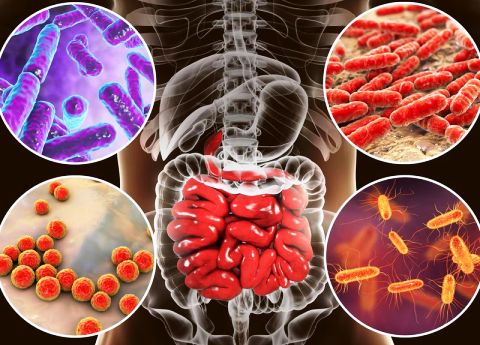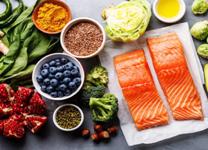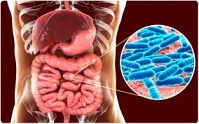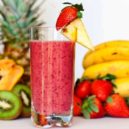LOSE WEIGHT DURING THE LOCKDOWN WITHOUT EXERCISE-PART 4

We have now reached the fourth and the final edition of the diet plan that details an easy to implement ten-step plan that helps one shed weight during a lockdown without having to step into a gym. To those who have not read the first three parts, this instalment will not make any sense. So please revert to the first three editions either in the Deccan Chronicle newspaper dated March 31, 2020, April 7, 2020, and April 14, 2020, or check it out on my website @www.jayanthmurali.com.
And to those who have followed the previous steps scrupulously. Pat yourself on the back! You have done incredibly well! As you will soon reach the end of the incredible journey of saying sayonara to those extra, unwanted five kilograms.
 Before we dive deep into the final instalment of the diet plan, let me give you a gist of this effective weight loss regimen. This simple to implement diet plan envisages a ten-step process to shed 5 kgs during a month. Each step has corresponding points. Your goal is to achieve at least 60 points per day, i.e. 1800 points in a month. This equates to one losing five kgs in thirty days! The cherry on the top of the cake? No tiresome exercises, no stressful workouts and no costly gym-membership!
Before we dive deep into the final instalment of the diet plan, let me give you a gist of this effective weight loss regimen. This simple to implement diet plan envisages a ten-step process to shed 5 kgs during a month. Each step has corresponding points. Your goal is to achieve at least 60 points per day, i.e. 1800 points in a month. This equates to one losing five kgs in thirty days! The cherry on the top of the cake? No tiresome exercises, no stressful workouts and no costly gym-membership!
Here we go! To begin with, we think we are human beings, but in the real sense we are more of microbial beings because we are host to about 100 trillion bacterial cells, so we comprise ten times more microbial cells than the human cells. With two million genes in 300 to 500 different kinds of bacteria in our gut, the microbiome contains ten times the amount of genes that we have in our human genomes.
The microbes in our gut play a key role in digesting the food and synthesising nutrients from our diet. The microbiome in our gut gets influenced by our diets, by our lifestyle and the microbiome we inherit from our parents which in turn affects our mood, immune system and our metabolism.
 Some people, despite following a diet, don’t seem to lose weight because gut bacteria may determine how easy or how hard it is for one to lose weight. The gut bacteria can affect how one’s food is digested, how the fat gets stored, and whether one feels hungry or full. Thus, healthy gut bacteria may be essential for maintaining a healthy weight.
Some people, despite following a diet, don’t seem to lose weight because gut bacteria may determine how easy or how hard it is for one to lose weight. The gut bacteria can affect how one’s food is digested, how the fat gets stored, and whether one feels hungry or full. Thus, healthy gut bacteria may be essential for maintaining a healthy weight.
Research in mice has revealed how gut microflora may play an important role in obesity. The relative abundance of two dominant types of bacteria, Bacteroidetes and Firmicutes, determine whether mice will be obese or thin. They also found that colonising microbiota from lean mice into obese mice made the obese mice thin, and vice versa. The gut microbiome plays a vital role in weight loss, insulin resistance and fat deposition In another experiment, colonising mice ‘gut with bacteria called Clostridium made them leaner by blocking the intestine’s ability to absorb fat. Importance of faecal transplants and probiotics are now being widely investigated as ways to restore a healthy microbiota.
There also seems to be a link between the gut microbiome and the immune system. The gut bacteria probably produce many biochemicals which boosts the immune system. If one immediately controls the health of the trillions of microbes living in our gut, we will not only strengthen your immune system from inside against the COVID 19 virus but also lose weight quickly with little effort. The declining microbial diversity in our gut is the leading cause for our susceptibility to Coronavirus and other pathogens.
 So, a healthy microbiome which has diverse microbiomes can prevent potentially dangerous immune overreactions that damage lungs and other vital organs. One reason immunity decreases as we age is because microbial diversity in our gut decreases as we age.
So, a healthy microbiome which has diverse microbiomes can prevent potentially dangerous immune overreactions that damage lungs and other vital organs. One reason immunity decreases as we age is because microbial diversity in our gut decreases as we age.
Besides, gut microbes are happy to provide weight loss and other health-promoting services in return for plant-based foods and healthy fats. Getting 30 grams of fibre from plants of different colours helps diversify our microbiota, which contributes to our overall health. The gut microbiome of overweight individuals shows dysbiosis associated with inflammation and lowered immune function. This is because of the increased extraction of energy from food.
Hence, eating a wide range of plant-based foods high in fibre such as eating plenty of fruit, vegetables, nuts, seeds and whole grains; healthy fats like high-quality extra virgin olive oil; lean meat or fish, avoiding alcohol, salt, sweets and sugary drinks, and artificial sweeteners or other additives improves the composition of the gut microbiome.
There is ample evidence to show that dietary fibre and microbial diversity complement each other for weight loss and different positive health outcomes in humans. The microbes feast on the fibre from plant foods which resist digestion by enzymes produced by human beings but are devoured by the bacteria in the gut when they arrive there. That is the reason why I had suggested consuming psyllium husk in one of the previous steps of this diet plan. Microorganisms in the gut extract the nutrients, vitamins and energy in the fibres to produce various bio-compounds and short-chain fatty acids which are being linked to improved immune function, weight loss and decreased inflammation.
We can also support our microbiome by regularly eating natural yoghurt and cheeses, which contain live microbes (probiotics). Traditional fermented foods made from whole grains, like idlis, dosas and fermented rice are another option. Antibiotics are harmful to the microbiome and have a damaging effect on our microbiome diversity. The gut bacteria also produce neurotransmitters that regulate our mood, including serotonin, dopamine, and GABA. Researchers have discovered a second nervous system in the gut which communicates with the brain. The wellness of both our body and our mind, therefore, largely depends on our gut health.
 Keeping in mind the clout the microflora in our gut has on our health, let us now embark on the ninth step of the diet plan in which we try to leverage the human microbiome for weight loss. Every time an individual implements this step, he or she will earn ten reward points. This step envisages having two handfuls or 75 grams of raw, fresh raw vegetable salad along with every main meal. Fresh and raw vegetables are not only full of minerals and vitamins but also have a meagre calorie count. Salads add volume to one’s meal along with the vital fibre that helps in digestion. When one adds quantity to a meal with such nutritional powerhouses, a person will consume less high-calorie foods. The high water content in fresh vegetables will further fill up one’s stomach. As a result, one will eat smaller portions of the main course. A sine qua non to making the salad enjoyable is to make the salad both visually appealing and tasty, by garnishing the raw vegetables as per your taste, with spices and good salad dressing which tingles your taste buds.
Keeping in mind the clout the microflora in our gut has on our health, let us now embark on the ninth step of the diet plan in which we try to leverage the human microbiome for weight loss. Every time an individual implements this step, he or she will earn ten reward points. This step envisages having two handfuls or 75 grams of raw, fresh raw vegetable salad along with every main meal. Fresh and raw vegetables are not only full of minerals and vitamins but also have a meagre calorie count. Salads add volume to one’s meal along with the vital fibre that helps in digestion. When one adds quantity to a meal with such nutritional powerhouses, a person will consume less high-calorie foods. The high water content in fresh vegetables will further fill up one’s stomach. As a result, one will eat smaller portions of the main course. A sine qua non to making the salad enjoyable is to make the salad both visually appealing and tasty, by garnishing the raw vegetables as per your taste, with spices and good salad dressing which tingles your taste buds.
The main meal accompanying the salad should be plant-based whole foods with minimum animal products and processed items. A” plant-based diet” which is being suggested here means plant foods like vegetables, fruits, whole grains, legumes, and nuts as the main items, but it does not stop one from including small amounts of eggs, poultry, seafood, meat or dairy. The focus here is on eating more of the right plants, avoiding the wrong kind, eliminating unhealthy foods, and moderating one’s intake of healthier animal products.
During pandemics, one may always think about food because of boredom, fear and anxiety. There may be an unquenchable desire to go binge on the tastiest snack at two in the night? Such unhealthy eating habits we can put to an end by adding lots of proteins and fat to one’s meal. Proteins not only increase your metabolism but can also reduce your calorie intake by 400 calories per day! This diet plan also envisages combining the benefits of a plant-based diet with that of Keto diet by adding liberal amounts of fats from avocados, olives, oils, nuts, seeds, coconut, pasture-raised eggs and ghee. This diet eliminates problems of conventional Keto diets where consumption of large amounts of meat, high-fat dairy, and things like butter coffee can wreak havoc on your microbiome. Hence, the penultimate step in the journey to being slimmer is to load every meal with a potent mix of plant-based proteins, fats and low carbohydrates. The basic idea is to lower insulin, to help the body burn more fat. Furthermore, with a lower level of insulin, the kidneys work to remove both excess water and sodium from the body. This means–hey, no more bloating and that hideous water weight!
Thus, in this diet plan, I recommend 40% calories from carbohydrates, 30% from proteins and 30% from fat with a focus on the whole, unrefined carbohydrate sources and whole-food fats. Some protein sources for the vegetarians could be soy protein like tofu, Quinoa protein, hemp protein, legumes of various kinds and nuts. For vegans, protein sources could be soy protein tofu, legumes like Chickpeas, Green Peas, Lentils, etc. peanut butter, almond butter and hemp protein. There is no dearth of proteins for non -vegetarians as all meats, fish and seafood and eggs are rich in proteins. However, only minimal use of animal proteins gets allowed on this diet plan. The bulk of the meal may, however, comprise whole grains and low carb vegetables such as Broccoli, Cauliflower, Spinach and all green leafy vegetables, Brussels Sprouts, Lettuce, Cucumber, Celery etc. For cooking the meal, good sources of fat, such as olive, avocado or coconut oil may be used. However, coconut oil is the best as it has medium-chain triglycerides (MCT) oil. Oils containing MCT fats help satiate more than other oils, plus they boost metabolic rate, besides they also help one get into ketosis and fat-burning mode.
The last and final step in the diet plan which will fetch one, two reward points is the practice of drinking a small cup of hot water after each meal to which we have added a twist of lemon after the hot water has been simmered with a few ginger slices, one teaspoon of cinnamon and a pinch of turmeric. The secret of fat loss is not to have your sugar levels rise after your meal. Cinnamon prevents blood sugar from spiking, and thus helps in controlling one’s blood sugar levels. One should drink this immediately after one has eaten his meal. At this point, you may be probably shaking the head and furrowing those eyebrows. It may be because, in one of my previous steps, I had mentioned that one should avoid gulping water until 2 hrs after a meal? Read through this step once again. Drink only a small cup of water. It is when we drink more than a glass or two that digestive issues arise. You might wonder at the efficacy of taking warm water after meals to lose weight. Au contraire mon ami, warm water spurs on weight loss as per research and studies. This is because heated water increases the speed of metabolism by increasing the body temperature. Additionally, it washes down any food particles that may get stuck in the food pipe after we have had our fill of gastronomic pleasures. The spices we have added to the cup of water help remove any toxins from our system. They even decrease bloating, a common issue with people living in warm countries.
We have now come to the end of the ten-step diet plan. A diet plan without exercise as the gyms remain shut during a pandemic. During regular times going to the gym is cumbersome and expensive for most of us, besides it requires too much effort. My diet plan takes a hard pass on both these issues. I have based every step of this weight loss journey on scientific research and practical results. Make sure to achieve the grand total of 1800 points at the end of the month. Grab that goal and work towards your dream physique! Once there, you will be amazed to see the results. Get ready to garner admiration from all quarters! One last tip before I say adios and wish you all luck: consistency is the key. Be consistent, try scoring a minimum of 60 points out of 75 points, in the ten steps. You might, in the end, get blown away after seeing the incredible results.
Source from: epaper/deccanchronicle/chennai/dt:21.04.2020
 Dr.K. Jayanth Murali is an IPS Officer belonging to 1991 batch. He is borne on Tamil Nadu cadre. He lives with his family in Chennai, India. He is currently serving the Government of Tamil Nadu as Additional Director General of Police, Law and Order.
Dr.K. Jayanth Murali is an IPS Officer belonging to 1991 batch. He is borne on Tamil Nadu cadre. He lives with his family in Chennai, India. He is currently serving the Government of Tamil Nadu as Additional Director General of Police, Law and Order.


Apr 21, 2020 at 1:31 PM /
very good article. Very lengthy. Intellectual distance is very long.